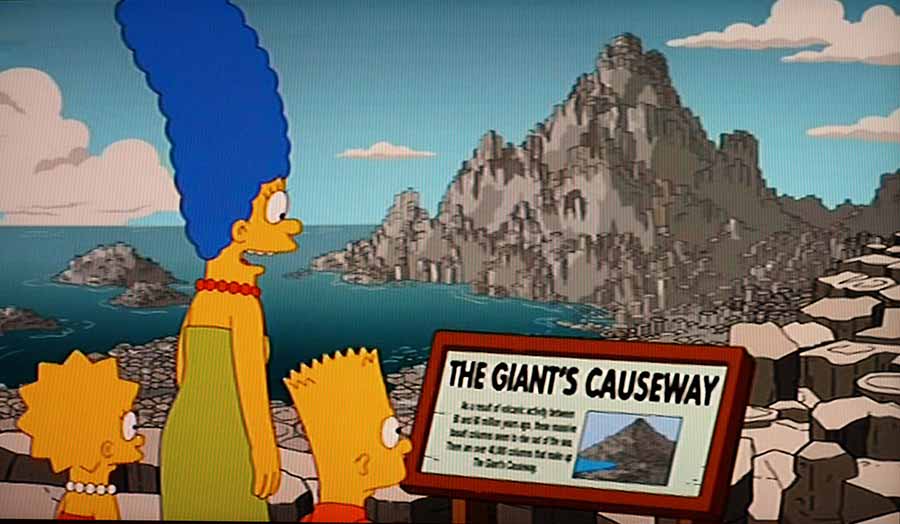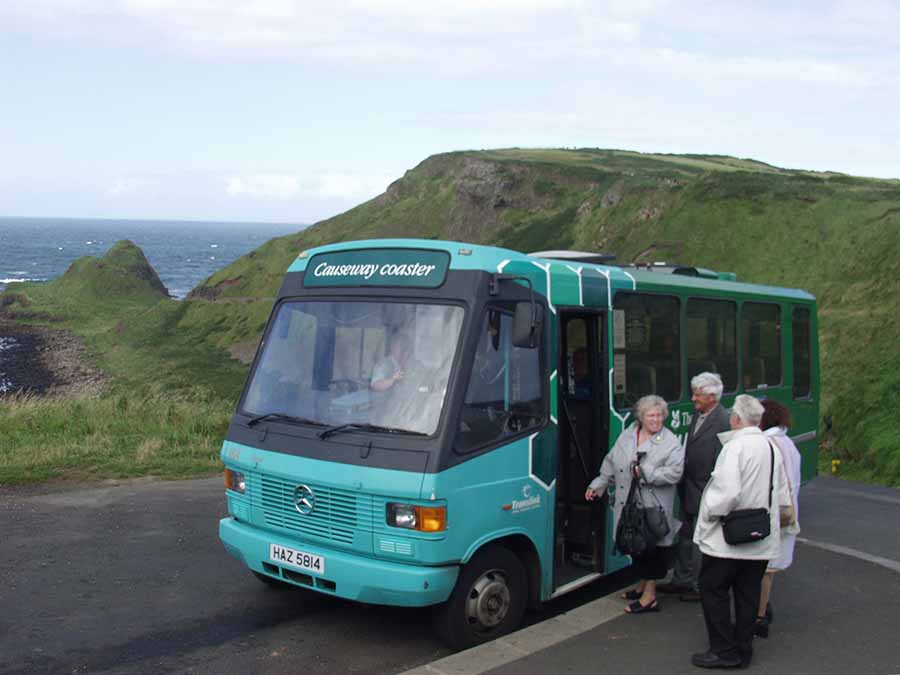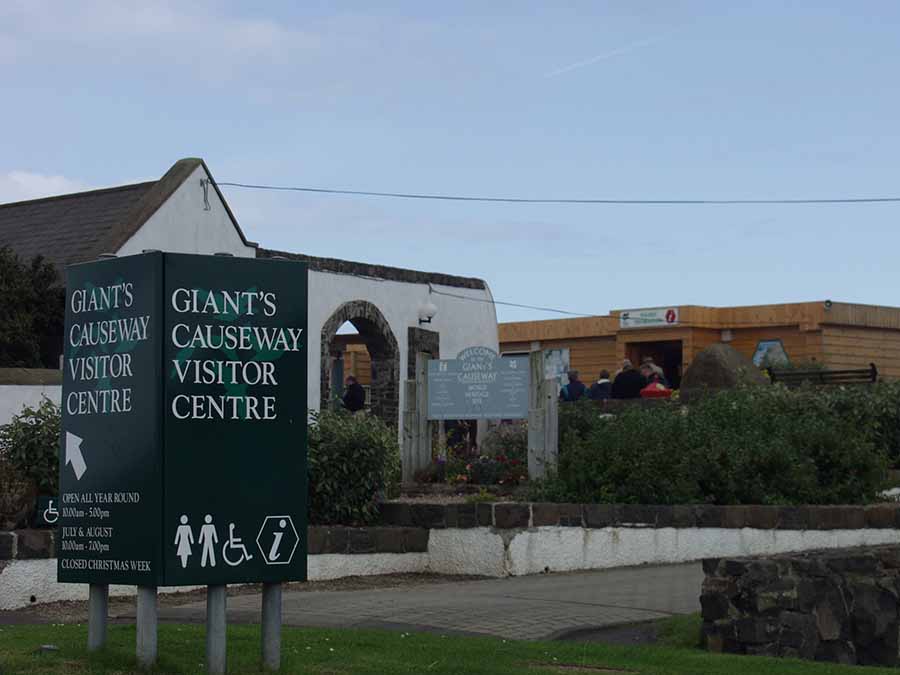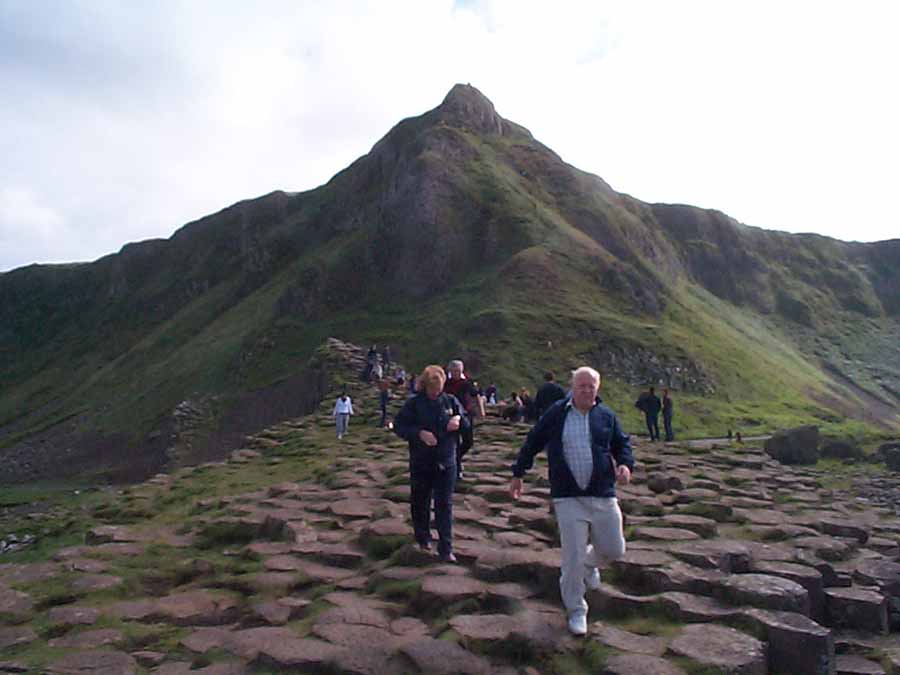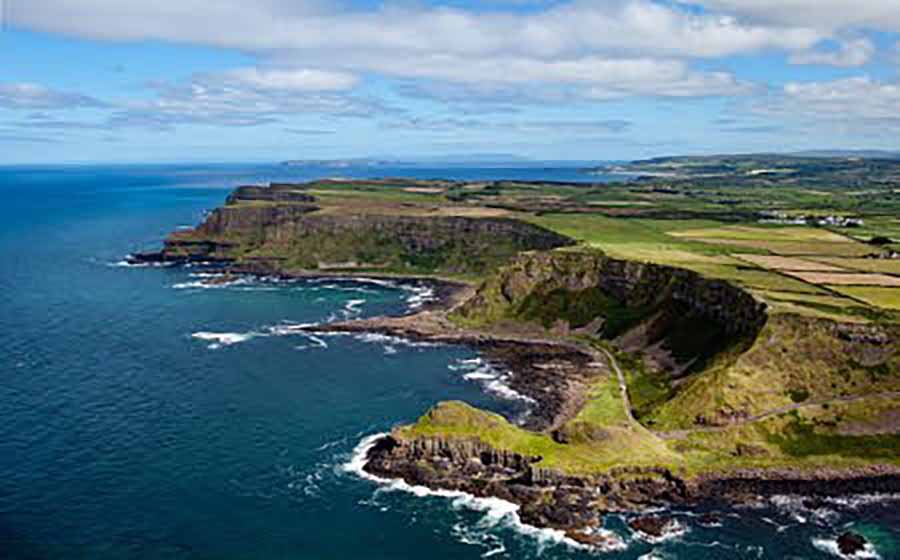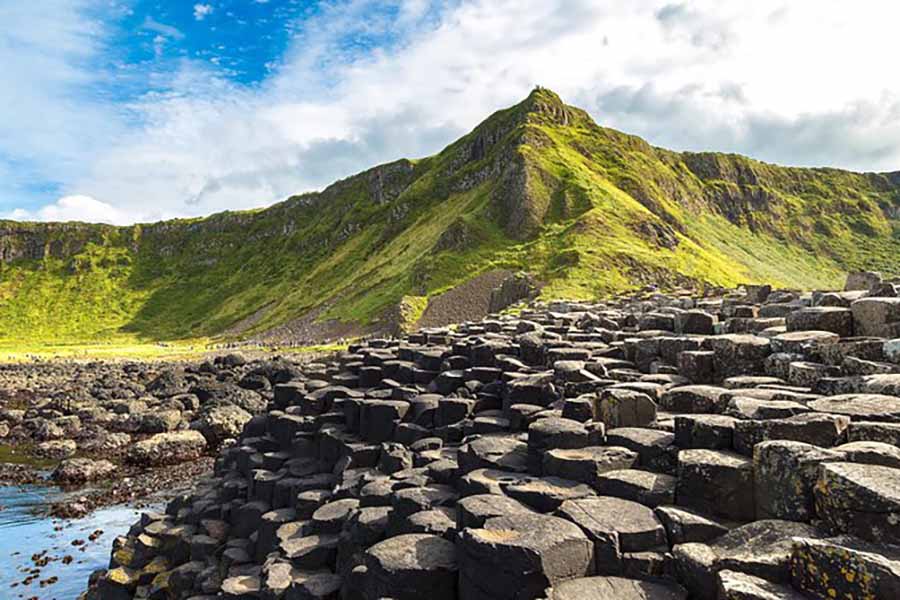
The Giant’s Causeway, located on the north coast of County Antrim, is a UNESCO World Heritage Site and one of Ireland’s most iconic natural wonders. Formed by volcanic activity 50–60m years ago, it features approximately 40,000 interlocking basalt columns, steeped in both geological marvel and the folklore of the Irish giant Finn McCool. Managed by the National Trust, it attracted 684,000 visitors in 2024, with numbers approaching the pre-pandemic peak of nearly 1m in 2019.
A visit to the Giant’s Causeway offers a blend of natural beauty, myth, and educational experiences, typically lasting 2–4 hours depending on trails and activities. The site is accessible year-round, with the Visitor Centre open daily from 9:00 AM to 5:00 PM (last admission at 4:00 PM), though the coastline remains open from dusk to dawn. Here’s a breakdown of the core experience:
The Causeway Stones and Coastal Scenery:
- The main attraction is the Grand Causeway, a collection of hexagonal basalt columns formed by cooled lava, jutting into the North Atlantic. Visitors can walk across the stones, marveling at their geometric precision, with notable formations like the Giant’s Boot, the Organ, and Humphrey the Camel.
- The surrounding landscape features dramatic cliffs, secluded bays, and views toward Scotland (20 miles away on clear days). Seabirds like fulmars, guillemots, razorbills, and oystercatchers are common, and rare plants such as sea spleenwort and frog orchids thrive in the weathered rocks.
Four walking trails cater to different fitness levels:
- Blue Trail (0.8 miles, 15–30 minutes): A gentle, mostly flat path from the Visitor Centre to the Grand Causeway, suitable for all ages.
- Red Trail (partially closed): A cliff-top hike with stunning coastal views, but sections are restricted due to rockfall risks.
- Green Trail: A shorter, accessible loop near the Visitor Centre, ideal for those with mobility issues.
- Yellow Trail: A longer, more challenging route via Runkerry House to Hamilton’s Seat, taking several hours.
- The Causeway is free to access on foot via public paths, but sturdy shoes are essential due to slippery, uneven surfaces, especially in wet or windy conditions (common along the coast).
Visitor Centre Experience:
The award-winning Visitor Centre, opened in 2012 and designed by Mayo-born architect Róisín Heneghan (who also designed the new Egyptian Archaeological museum in Cairo), is built with basalt to reflect the Causeway’s geology. It offers:
- Interactive Exhibition: Explores the Causeway’s formation, Finn McCool folklore, and local wildlife, with kid-friendly displays and touch-screen maps.
- Audio Guides: Available in 11 languages, guiding visitors through the site’s history and legends (included with Visitor Experience tickets).
- Guided Tours: Hourly tours by the National Trust’s storytelling team blend science and myth, starting at the Visitor Centre (included in tickets).
- Admission: Pedestrian access to the Causeway is free, but the Visitor Experience ticket (€16.50/£13 adult, €8.25/£6.50 child, €41.25/£32.50 family at the gate; €1.50–€3.50 less online) includes parking, guided tours, audio guides, exhibition access, café, shop, and facilities. National Trust members enter free but should pre-book. Under 5s are free.
- Critiques: Some visitors find the Visitor Centre underwhelming, describing exhibits as basic and the café overpriced. Many recommend skipping it and walking directly to the stones to save costs.
- An unintentional curiosity is the creationist exhibit that claimed the world was created in 4004BC and dismissing the geological origin of the causeway 60m years ago as “a theory.” It was inserted as the insistence of local DUP politicians. The original audio which accompanied the exhibit originally said “Young Earth Creationists believe that the earth was created some 6000 years ago. This is based on a specific interpretation of the Bble and, in particular, the account of creation in the book of Genesis. Some people around the world, and specifically here, share this perspective.”
- In 2012 it was replaced by a new audio that said: “There is a clear understanding among scientists that the heat of the earth was the driving force behind the formation of the Giant’s Causeway. The earth is far older than had previously been thought. All the scientific evidence points to a volcanic origin for the columns of the Giant’s Causeway, around 60m years ago. However, not everyone agrees with the scientific view. There are some people who believe – often for religious reasons – that the earth was formed more recently: thousands of years ago rather than billions.”
Accessibility and Transport Options:
- Shuttle Bus: A Translink-operated accessible bus runs from the Visitor Centre to the Grand Causeway (€1.20/£1 each way, free for National Trust members with a valid card). It’s wheelchair-accessible with priority seating and accommodates mobility needs.
- Accessibility Equipment: Free wheelchairs and all-terrain mobility scooters are available on a first-come, first-served basis for Visitor Experience ticket holders. The Green Trail and Visitor Centre are fully accessible, with a Changing Places facility and exterior toilets at the Causeway Hotel.
- Parking: The main car park is reserved for Visitor Experience ticket holders and National Trust members (pre-booking required). Alternative parking at Causeway Coast Way Car Park (Innisfree Farm, 60 Causeway Rd, €12.70/£10, card only) or Bushmills Park and Ride (Dundarave Car Park, €12/£9 with “Green Ticket” discount) allows access to trails without Visitor Centre fees.
- Getting There: Located at 44 Causeway Rd, Bushmills, BT57 8SU, it’s 3.2 km north of Bushmills, 11 miles from Coleraine, and 13 miles from Ballycastle. By car, it’s a 1-hour drive from Belfast or 1.5 hours from Derry. Translink buses connect from Belfast, Coleraine, or Bushmills, and the Giant’s Causeway & Bushmills Railway offers a scenic tram from Bushmills (€6.35/£5 adult, €3.80/£3 child, parking included). Guided tours from Belfast or Dublin often include stops at Dunluce Castle or Carrick-a-Rede Rope Bridge.
Dining and Amenities:
- Visitor Centre Café: Offers refreshments and snacks, but reviews suggest high prices and average quality. Packing a lunch is advised.
- The Nook: A nearby restaurant in a charming old building with a red phone box, serving lunch from 11:00 AM to 5:00 PM.
- Causeway Hotel: Adjacent to the Visitor Centre, it provides takeaway drinks, dine-in meals (breakfast, brunch, lunch, dinner), and public toilets open later than the Centre’s.
- Gift Shop: Sells local artisan crafts and souvenirs, with proceeds supporting National Trust conservation. Some find it overpriced.
- Facilities: Toilets, Changing Places, free Wi-Fi, and a Bureau de Change are available in the Visitor Centre. Dogs are welcome (on leads) indoors and out, with water bowls provided.
Cultural and Geological Significance:
- The Causeway’s 40,000 basalt columns, formed during the Paleocene Epoch, are a geological marvel, with similar formations at Fingal’s Cave, Scotland. The legend of Finn McCool, who built the Causeway to challenge Scottish giant Benandonner, adds a mythical allure.
- The site is a haven for wildlife, including seabirds and rare plants. A stromatolite colony, typically found in warmer waters, was discovered in 2011, adding scientific intrigue.
- Its UNESCO status (1986) and ranking as fourth-greatest natural wonder (Radio Times, 2005) underscore its global importance.
Practical Tips:
- Timing: Visit before 11:00 AM or after 2:00 PM to avoid peak crowds (midday, especially June–August). Sunset offers stunning light for photographers, with fog sometimes adding a mystical effect.
- Weather: Expect wind and rain; bring waterproof clothing, hats, and sturdy shoes (no sandals or heels). Check www.metoffice.gov.uk for forecasts.
- Safety: Stick to designated paths, as rocks are slippery when wet. Avoid climbing high or nearing the water’s edge. First-aid-trained staff are onsite.
- Free Access: Walk from Bushmills (2 miles) or park at Causeway Coast Way (€12.70/£10) or Bushmills Park and Ride to avoid Visitor Centre fees.
What’s New for 2025
- Coin Removal Initiative: A significant conservation effort addresses the issue of coins jammed into the basalt columns, particularly at The Loom, where they cause physical and chemical damage (e.g., discoloration). A specialist stonemason began removing coins in 2024, clearing about 10% so far, with work continuing into 2025. New signage and tour guide warnings urge visitors not to insert coins, preserving the UNESCO site’s integrity.
- Enhanced Accessibility: The National Trust is expanding accessibility equipment, with additional wheelchairs and all-terrain scooters available for loan. The Translink shuttle bus now emphasizes priority for those with mobility needs, and the Changing Places facility is promoted for broader use during Visitor Centre hours (9:00 AM–5:00 PM).
- Guided Tour Enhancements: The storytelling team has introduced a “Birds of the Causeway” worksheet for 2025, available at the Visitor Centre, to help visitors identify local wildlife like robins, stoats, eider ducks, and Northern gannets. This complements hourly guided tours, enhancing the educational experience.
- Sustainability Focus: The National Trust’s conservation efforts include cattle grazing to promote wildflowers, rare snails, and insects on coastal slopes, continuing into 2025. The Visitor Centre’s eco-friendly design (e.g., ground-source heat pumps, basalt materials) supports its green credentials, aligning with the Trust’s mission as Europe’s largest conservation charity.
- Visitor Management: Pre-booking for Visitor Experience tickets is now strongly emphasized to manage the expected 700,000+ visitors in 2025, reducing congestion during peak summer months (June 30–August 31, when peak pricing applies). Online booking offers €1.50–€3.50 discounts, and the “Green Ticket” Park and Ride from Bushmills (€15.25/£12 adult, €7.60/£6 child) remains a cost-effective option.
Tips for Visitors
- Book Early: Reserve Visitor Experience tickets at www.giantscausewaytickets.com to save on fees and secure parking, especially in summer. National Trust members should also pre-book.
- Go Early or Late: Arrive before 11:00 AM or after 2:00 PM for fewer crowds and better photo opportunities, especially at sunset.
- Free Access Option: Park at Causeway Coast Way (€12.70/£10) or Bushmills Park and Ride and walk the public path (via the tunnel behind the Visitor Centre) to avoid Visitor Centre costs.
- Combine with Nearby Sites: Visit Dunluce Castle (10-minute drive), Carrick-a-Rede Rope Bridge (15 minutes), or Old Bushmills Distillery (5 minutes). The Causeway Coastal Route offers scenic drives to Portrush or the Dark Hedges.
- Safety First: Wear sturdy shoes, avoid climbing high on wet rocks, and heed staff warnings about water’s edge. Don’t insert coins into rocks to protect the site.
- Budget Wisely: Pack a lunch to avoid pricey café food. The Nook or Causeway Hotel offer dining alternatives.
